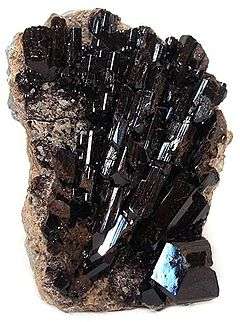Fluor-buergerite
| Fluor-buergerite | |
|---|---|
 | |
| General | |
| Category |
Cyclosilicate tourmaline |
| Formula (repeating unit) | NaFe3+3Al6(BO3)3Si6O18(O,F,OH)4 |
| Strunz classification | 09.CK.05 |
| Identification | |
| Color | Bronze, dark brown, black |
| Crystal system | Trigonal - ditrigonal pyramidal (3m) |
| Cleavage | Distinct prismatic |
| Mohs scale hardness | 7 |
| Streak | yellowish brown |
| Diaphaneity | Translucent |
| Specific gravity | 3.31 |
| Optical properties | Uniaxial (-) |
| Refractive index | nω = 1.735 nε = 1.655 |
| Birefringence | δ = 0.080 |
| Other characteristics | Pyroelectric and piezoelectric |
| References | [1][2][3] |
Fluor-buergerite,[4] originally named buergerite, is a mineral species belonging to the tourmaline group. It was first described for an occurrence in rhyolitic cavities near Mexquitic, San Luis Potosi, Mexico. It was approved as a mineral in 1966 by the IMA and named in honor of Martin J. Buerger (1903–1986) Professor of Mineralogy at the Massachusetts Institute of Technology. It has also been reported from Minas Gerais, Brazil, and the Central Bohemia Region of the Czech Republic.[1][2][3]
References
- 1 2 Handbook of Mineralogy
- 1 2 Mindat
- 1 2 Webmineral data
- ↑ Darrell J. Henry, Milan Novák, Frank C. Hawthorne, Andreas Ertl, Barbara L. Dutrow, Pavel Uher, and Federico Pezzotta (2011). "Nomenclature of the tourmaline-supergroup minerals" (PDF). American Mineralogist 96: 895–913. doi:10.2138/am.2011.3636.
| Wikimedia Commons has media related to buergerite. |
This article is issued from Wikipedia - version of the Sunday, June 02, 2013. The text is available under the Creative Commons Attribution/Share Alike but additional terms may apply for the media files.